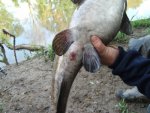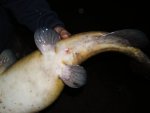I know we are a good ways away from this target fish but for anyone interested in trying to tie into one of these fish, this is as good a time as any to start learning some new tricks.
I will put what has worked for me up here and hope that maybe someone else also has some tips they dont mind sharing.
____________ #1
Favorite Rig
My favorite Flathead rig pictured is for keeping the bait pinned in current or when fishing up against structure. Keeps the bait off the bottom and I have caught alot more fish since I have been using this set up. Can be a pain to cast but it works great.
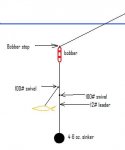
CLICK
I use the light leader to the weight so that I can get an easy break off if the weight gets lodged and that's why I use a large swivel... so that the bait leader swivel will hold against it. The bait is free to swim up or down between the swivel and bobber. The bait leader swivel acts like a three way... allowing the bait to swim in circles without tangling in the main line.
I don't know if this is something others have seen but I haven't seen anyone use it where I have fished. Sometimes I will just leave the bobber stop off so that the fish is allowed to run without feeling the weight.... such as when using a kahle and clicker. Doing this requires (IMO) a very long rod to make up that double line on the hook set and that's why I use a 14' rod when setting up this way. 8' rod seems to work fine when tight lining with a circle hook.
___________#2
Bait
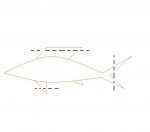
CLICK
I like to use panfish when I can and I always trim the spines off the fins before hooking them up. I also cut the tail fin way down so that the bait must move more to keep righted. I try and keep the amount I take off the dorsal and pectoral fins to a minimum. If too much is taken off, then the bait will have to work to hard to stay righted, which will stress out the bait and kill it faster.
This is a technique that I learned while bottom fishing for grouper on party boats. The grouper always seemed to hammer the baits that were modified in such a way, compared to those baits that were left natural. This is why I started doing the same thing for Flatheads.
I will mention that when I am running a flathead rig with such a bait, I will occasionally catch very large channel cats and this has happened many times while I am fishing among people who are targeting channels but are not catching the larger ones that I take. This has been the rule and not the exception... So I felt it was worth mentioning.
Not sure if this is common knowledge.... again, I have not seen others doing the same thing so this may be a good tip for those wanting to try something new in their approach.
_____________#3
Something I have been trying
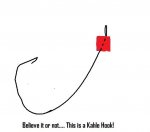
......CLICK
This may explain why I sometimes attract those channel cats.
Last year I started adding more pizazz to my live baits by attaching a section of sponge to my hook, before attaching my bait fish. I use those little dish sponges that are maybe a 1/2" X 5" X 3" that you would typically see with or without the scrubbing side on them. I get the smooth ones for this. I will cut the sponge in to 1" X 1" sections and throw them in my tackle box so they are ready to use.
When I am ready, I will use a fish oil to saturate them and then push the barb of the hook through the center. Sometimes when I tie the hook, I will leave maybe 3/8" of line past the knot and then push the sponge past that tab so that the sponge cannot slide back down onto the hook. Most times I put it just as it is in the attachment above.
I like the idea of adding one more attractant that aids the flatheads in finding my bait but I am still playing with attractant types since the performance is hit and miss. When I don't catch fish... is it the fact that there were none or that they just didn't like my attractant?.
This is why I am on and off with this idea. It's hard to commit to something that doesn't show above average results but I really believe this makes sense.
Figured I would mention it in case someone has a suggestion for improving on this attractor.
#4
Philosophy on shoreline fishing
I have really put a lot of time into this fish as far as study goes and while I have not had the opportunity to apply the boating principals on rivers, I don't know as I have seen area's (while in my boat) that are better than the shoreline when talking about the lakes I have fished. That is to say any spot that I want to fish can be accessed from a shoreline.
I suppose if you cant get to the shore line of an island or the outer shoreline of a lake and a boat is the only way to get it done, then you need a boat but my point is that the best fishing is generally near the shore IMO.
The biggest Flatheads I have seen taken out of the lakes I have fished have come from water that averages less that half the average depth of the lake from which they were taken. Many times the big fish are taken within 15' of shore or closer (on a cut out bank) which makes sense to me since much of the trash that is in a lake is at it's edges. Falling tree's, clean fill being dumped (illegal fill being dumped).... it all makes for good cover.
Shorelines also make great ambush points for predators as we all know. Much easier for a flatty to catch a fish in 2' of water than 10'.
I like cut out banks that fade to the bottom and don't bother with flats. I have never caught a good flathead on a flat but have caught many on the edge of a flat that drops away quickly. Sometimes such an area can be 100 yards off the shoreline but is still doable with the proper rod and a tough bait. An ell, an 8oz. bell sinker and a bobber would be an example of something that can be cast 100 yards or more with a 12-14' spin caster. such a bait will arrive at touch down in good condition and will be alive when flatty comes by an hour or two later.

CLICK
When fishing for flatheads I use two rods with one being set in 4'-6' of water and the other in 6'-8' of water or as close to those depths as can be judged. I run my baits 2' under the surface at all times so that the bait is trying to escape further than the bobber will allow. I don't use a bobber that the bait cannot pull down. I want my bobber sized so that a bait can take it down for maybe 30 seconds or a little longer and no less than half that time. The reason being is that if a bait can get close to the bottom it will continue to do so. After each run at the bottom the bait will rest and then attempt to dive again. This makes for a lot of movement... which attracts Mr. Flatty.
I do not like fishing close to cover and do not feel there is any reason to. I want to have cover close by but I will be 20' or more from it when the bait is taken. The largest flatheads I have seen would spool many people's rigs and strip a lot of drag on the best set ups. By the time I set the hook and lose what line I am going to lose on the first run... I don't want to be in the trash where a big cat can just tangle me up and break me off. My thought is that if I am using the right bait with the proper presentation I don't have to put it in his face because he will find it soon enough. A true trophy flathead isn't going to fill up on the fish around his home... he is going to have to roam around a bit to find that much food. 20-30' is close enough for me.
Now with all of this said.... I understand this is not the last word on the subject, so if you have something to add or point out to me... please do. I am always ready and willing to learn from other catfisherman out there
I will put what has worked for me up here and hope that maybe someone else also has some tips they dont mind sharing.
____________ #1
Favorite Rig
My favorite Flathead rig pictured is for keeping the bait pinned in current or when fishing up against structure. Keeps the bait off the bottom and I have caught alot more fish since I have been using this set up. Can be a pain to cast but it works great.

CLICK
I use the light leader to the weight so that I can get an easy break off if the weight gets lodged and that's why I use a large swivel... so that the bait leader swivel will hold against it. The bait is free to swim up or down between the swivel and bobber. The bait leader swivel acts like a three way... allowing the bait to swim in circles without tangling in the main line.
I don't know if this is something others have seen but I haven't seen anyone use it where I have fished. Sometimes I will just leave the bobber stop off so that the fish is allowed to run without feeling the weight.... such as when using a kahle and clicker. Doing this requires (IMO) a very long rod to make up that double line on the hook set and that's why I use a 14' rod when setting up this way. 8' rod seems to work fine when tight lining with a circle hook.
___________#2
Bait

CLICK
I like to use panfish when I can and I always trim the spines off the fins before hooking them up. I also cut the tail fin way down so that the bait must move more to keep righted. I try and keep the amount I take off the dorsal and pectoral fins to a minimum. If too much is taken off, then the bait will have to work to hard to stay righted, which will stress out the bait and kill it faster.
This is a technique that I learned while bottom fishing for grouper on party boats. The grouper always seemed to hammer the baits that were modified in such a way, compared to those baits that were left natural. This is why I started doing the same thing for Flatheads.
I will mention that when I am running a flathead rig with such a bait, I will occasionally catch very large channel cats and this has happened many times while I am fishing among people who are targeting channels but are not catching the larger ones that I take. This has been the rule and not the exception... So I felt it was worth mentioning.
Not sure if this is common knowledge.... again, I have not seen others doing the same thing so this may be a good tip for those wanting to try something new in their approach.
_____________#3
Something I have been trying

......CLICK
This may explain why I sometimes attract those channel cats.
Last year I started adding more pizazz to my live baits by attaching a section of sponge to my hook, before attaching my bait fish. I use those little dish sponges that are maybe a 1/2" X 5" X 3" that you would typically see with or without the scrubbing side on them. I get the smooth ones for this. I will cut the sponge in to 1" X 1" sections and throw them in my tackle box so they are ready to use.
When I am ready, I will use a fish oil to saturate them and then push the barb of the hook through the center. Sometimes when I tie the hook, I will leave maybe 3/8" of line past the knot and then push the sponge past that tab so that the sponge cannot slide back down onto the hook. Most times I put it just as it is in the attachment above.
I like the idea of adding one more attractant that aids the flatheads in finding my bait but I am still playing with attractant types since the performance is hit and miss. When I don't catch fish... is it the fact that there were none or that they just didn't like my attractant?.
This is why I am on and off with this idea. It's hard to commit to something that doesn't show above average results but I really believe this makes sense.
Figured I would mention it in case someone has a suggestion for improving on this attractor.
#4
Philosophy on shoreline fishing
I have really put a lot of time into this fish as far as study goes and while I have not had the opportunity to apply the boating principals on rivers, I don't know as I have seen area's (while in my boat) that are better than the shoreline when talking about the lakes I have fished. That is to say any spot that I want to fish can be accessed from a shoreline.
I suppose if you cant get to the shore line of an island or the outer shoreline of a lake and a boat is the only way to get it done, then you need a boat but my point is that the best fishing is generally near the shore IMO.
The biggest Flatheads I have seen taken out of the lakes I have fished have come from water that averages less that half the average depth of the lake from which they were taken. Many times the big fish are taken within 15' of shore or closer (on a cut out bank) which makes sense to me since much of the trash that is in a lake is at it's edges. Falling tree's, clean fill being dumped (illegal fill being dumped).... it all makes for good cover.
Shorelines also make great ambush points for predators as we all know. Much easier for a flatty to catch a fish in 2' of water than 10'.
I like cut out banks that fade to the bottom and don't bother with flats. I have never caught a good flathead on a flat but have caught many on the edge of a flat that drops away quickly. Sometimes such an area can be 100 yards off the shoreline but is still doable with the proper rod and a tough bait. An ell, an 8oz. bell sinker and a bobber would be an example of something that can be cast 100 yards or more with a 12-14' spin caster. such a bait will arrive at touch down in good condition and will be alive when flatty comes by an hour or two later.

CLICK
When fishing for flatheads I use two rods with one being set in 4'-6' of water and the other in 6'-8' of water or as close to those depths as can be judged. I run my baits 2' under the surface at all times so that the bait is trying to escape further than the bobber will allow. I don't use a bobber that the bait cannot pull down. I want my bobber sized so that a bait can take it down for maybe 30 seconds or a little longer and no less than half that time. The reason being is that if a bait can get close to the bottom it will continue to do so. After each run at the bottom the bait will rest and then attempt to dive again. This makes for a lot of movement... which attracts Mr. Flatty.
I do not like fishing close to cover and do not feel there is any reason to. I want to have cover close by but I will be 20' or more from it when the bait is taken. The largest flatheads I have seen would spool many people's rigs and strip a lot of drag on the best set ups. By the time I set the hook and lose what line I am going to lose on the first run... I don't want to be in the trash where a big cat can just tangle me up and break me off. My thought is that if I am using the right bait with the proper presentation I don't have to put it in his face because he will find it soon enough. A true trophy flathead isn't going to fill up on the fish around his home... he is going to have to roam around a bit to find that much food. 20-30' is close enough for me.
Now with all of this said.... I understand this is not the last word on the subject, so if you have something to add or point out to me... please do. I am always ready and willing to learn from other catfisherman out there
Last edited:

